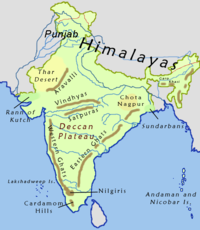Satpura
| Author:Laxman Burdak, IFS (R) |

Satpura (सतपुड़ा) is a range of hills in central India. The range rises in eastern Gujarat state running east through the border of Maharashtra and Madhya Pradesh to the east till Chhattisgarh.
Contents
Variants
- Satpura सतपुड़ा (AS, p.931)
- Satpura Range (सतपुड़ा पर्वतश्रेणी)
Location
The range parallels the Vindhya Range to the north, and these two east-west ranges divide Indian Subcontinent into the Indo-Gangetic plain of northern India and the Deccan Plateau of the south. The Narmada River originates from north-eastern end of Satpura in Amarkantak, and runs in the depression between the Satpura and Vindhya ranges, draining the northern slope of the Satpura range, running west towards the Arabian Sea. The Tapti River originates in the eastern-central part of Satpura, crossing the range in the center and running west at the range's southern slopes before meeting the Arabian Sea at Surat, draining the central and southern slopes of the range. Multai, the place of Tapi river origin is located about 465 kilometer far, south-westerly to Amarkantak, separated across by the hill range. The Godavari River and its tributaries drain the Deccan plateau, which lies south of the range, and the Mahanadi River drains the easternmost portion of the range. The Godavari and Mahanadi rivers flow into the Bay of Bengal. At its eastern end, the Satpura range meets the hills of the Chhotanagpur Plateau. The Satpura Range is a horst mountain and is flanked by Narmada Graben in the north and much smaller but parallel Tapi Graben in the south.[1][2]
History
Satpura is originally derived from Sanskrit word "Satpura" (Devnagari: सतपुड़ा), which means "Seven Mountains."
Ecology
Most of the Satpura range was heavily forested; but the area has been subject to gradual deforestation in recent decades, although significant stands of forests remain. These forest enclaves provide habitat to several at risk and endangered species, including the Bengal tiger (Panthera tigris tigris), Barasingha [3], gaur (Bos gaurus), dhole (Cuon alpinus), sloth bear (Melursus ursinus), chousingha (Tetracerus quadricornis), and blackbuck (Antilope cervicapra).
However, Satpura is now famous for numerous tiger reserves. Once upon a time, it was ruled by wild Indian elephants and lions[4]
Several protected areas have been earmarked in the area, including the Kanha, Pench, Gugamal and Satpura National Parks, Pachmarhi Biosphere Reserve, Melghat Tiger Reserve and the Bori Reserve Forest.
The Satpura Foundation, is a grass-roots organization that coordinates conservation efforts in the area, which continue to face challenges from development and infrastructure projects, logging and poaching.
Mythology
According to Harivamsa Purana 2.74.43 ff. there is an underground city of the Danavas (Daityas) under that mountain called "Satpur". Sri Krishna locked the doors of that city to prevent the Danavas (Daityas) to come out.
सतपुड़ा
सतपुड़ा (AS, p.931): विंध्याचल के दक्षिण में स्थित महान् पर्वत श्रेणी है। 'सतपुड़ा' शब्द 'सप्तपुत्र' का अपभ्रंश कहा जाता है। कुछ विद्वानों का मत है कि सतपुड़ा पर्वत की सात श्रेणियां हैं, जिसके कारण ही इसे 'सप्तपुत्र' का अभिधान दिया गया था। महाभारत में इस पर्वत को नर्मदा और ताप्ती के बीच में वर्णित किया गया है।[5]
External links
References
- ↑ Valdiya, K. S. (26 November 2015). The Making of India: Geodynamic Evolution. Springer. ISBN 9783319250298.
- ↑ Valdiya, K.S.; Sanwal, Jaishri (1 January 2017). Satpura Horst and Narmada–Tapi Grabens. Developments in Earth Surface Processes. 22. pp. 237–247. doi:10.1016/B978-0-444-63971-4.00010-4. ISBN 9780444639714.
- ↑ "Exploring the Jungles of Satpura"
- ↑ .www.banglalive.com
- ↑ Aitihasik Sthanavali by Vijayendra Kumar Mathur, p.931